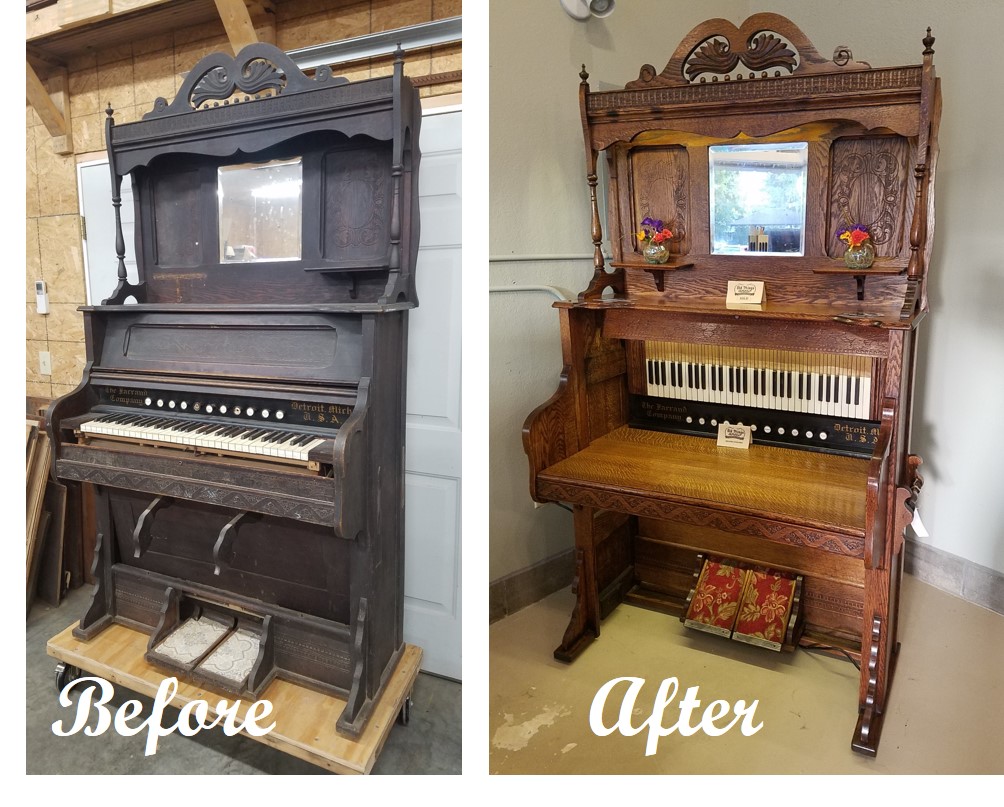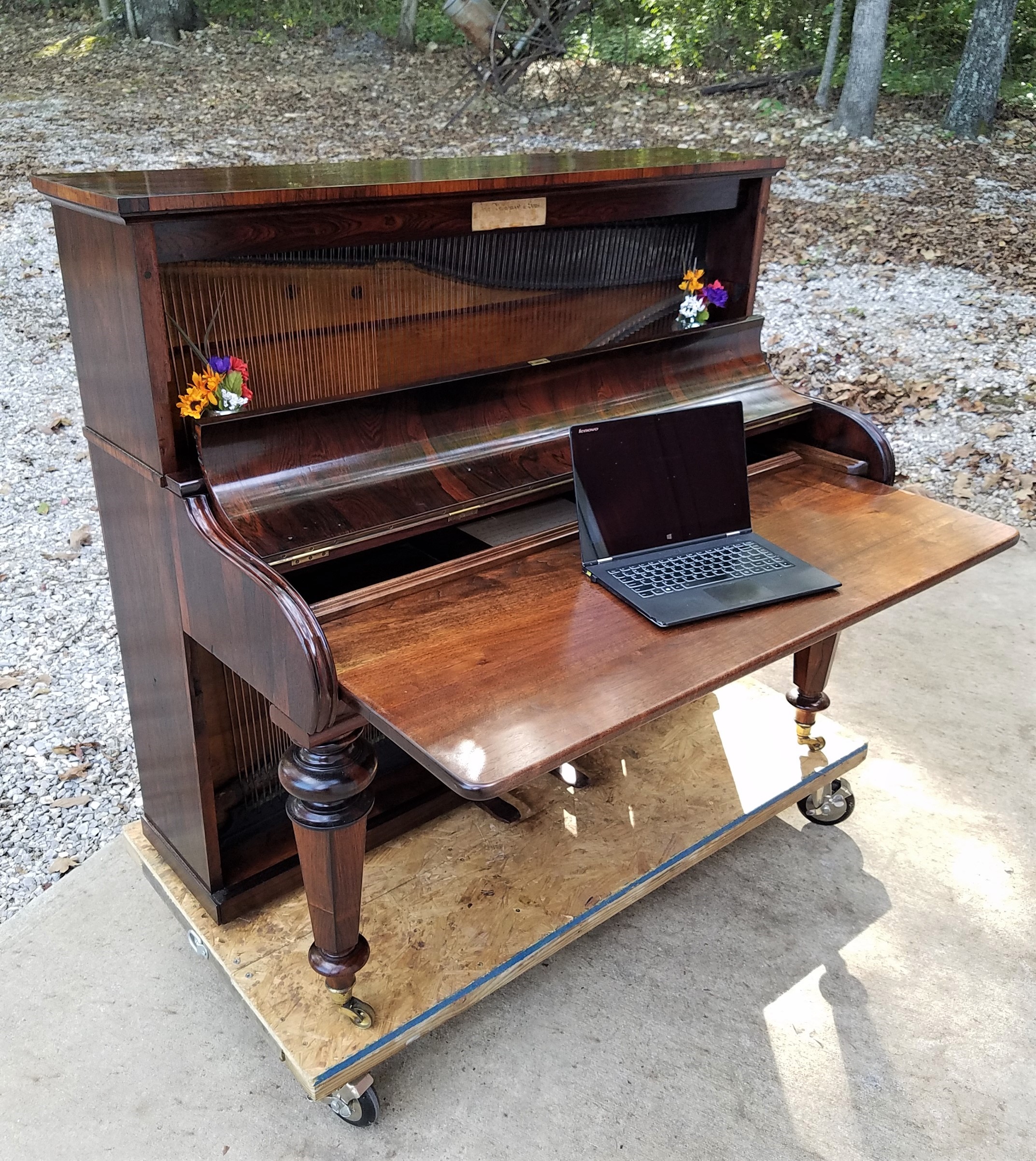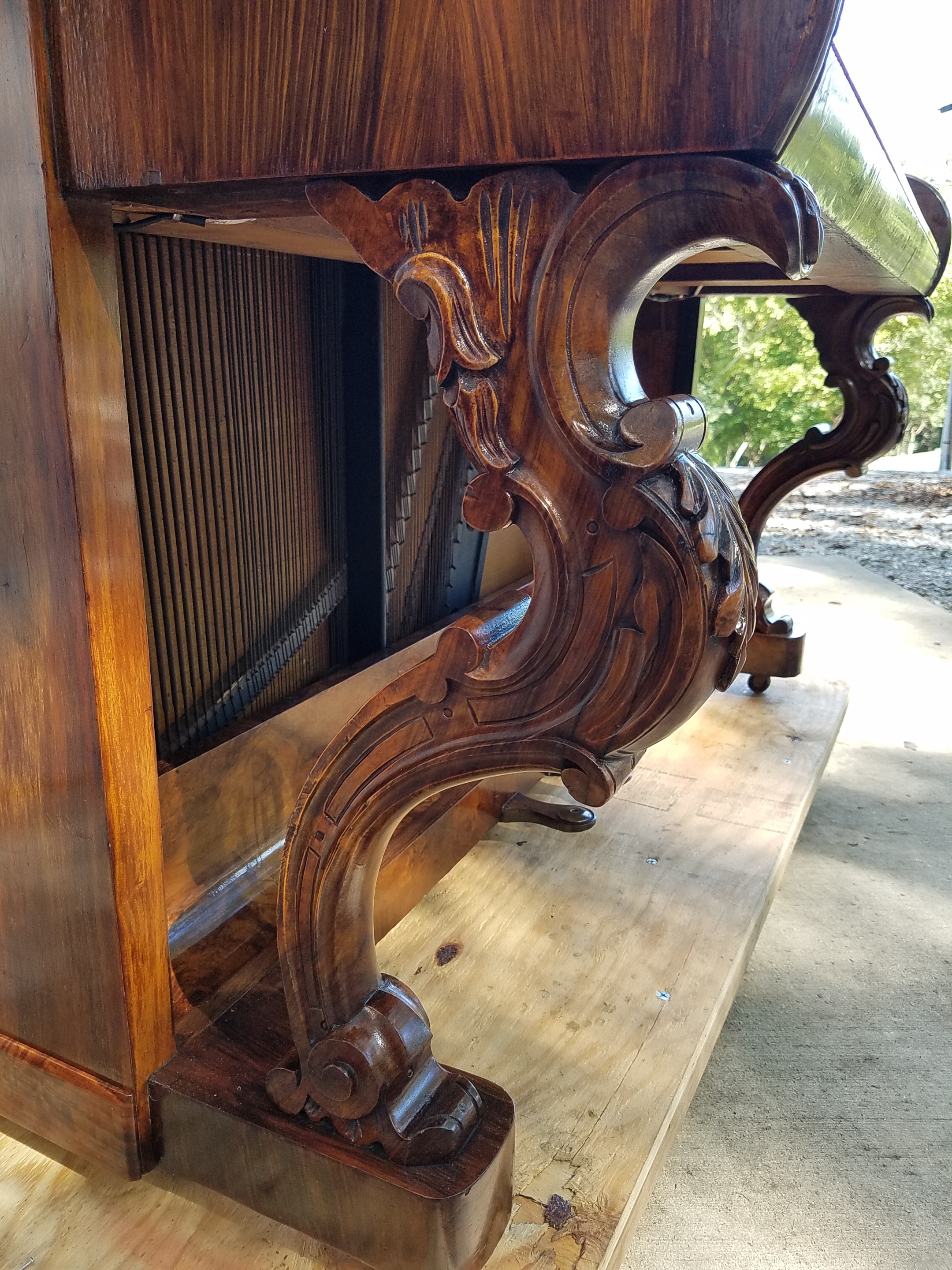Recently completed a commissioned customer piece who wanted to repurpose their inoperative family Everett baby grand piano into a useful and beautiful furniture shelving display unit. The piano had been in their family for decades and they hated to see it destroyed, as many fond memories were associated with the piano. I was able to completely disassemble the piano and restore the original mahogany piano casing, then built new hardwood maple shelves that were stained and finished in a lighter contrasting color from the original dark brown mahogany casing. We returned the original ivory keys and modified the original piano legs to allow the shelving unit to stand in a vertical position. Remote-controlled LED lighting was installed on the unit that gave the shelving unit a beautiful glow against a blue/gray wall with dark-colored wooden flooring. The family was very pleased with the results of this project and I predict it will be around for many generations to come.
c.1900, The Farrand Co. Tiger Oak “Piano Desk”

This Farrand oak pump organ is a personal repurpose/restoration job for a customer. It was manufactured in Detroit, Michigan between 1897 and 1914. This two piece non-working pump organ came to me in pretty rough shape, as the varnish finish on it was almost black in color and very crinkled from years of being exposed to the sun and unprotected environmental conditions. I complete disassembled this unit and stripped the old finish off followed by restoring the beautiful golden oak finish underneath the old varnish. I reconstructed the piece as a fully functioning “organ desk” by adding a new tiger oak desktop made from a similar age antique drop leaf table. I then moved the foot control board to a rearward position, thereby make it more comfortable to use as a desk. I then removed the original keyboard and pull stop knobs and placed them toward the rear side of the desktop for esthetics. Lastly, I added remote control LED light strips to the lower foot control unit, the desktop and to the upper hutch unit. This is a beautiful fully functioning family owned desk unit that I believe will allow it to be preserved for decades to come.
C. 1900, Estey Organ, Co. Tiger Oak “Piano Desk”


This pump organ was purchased in Alexander, Arkansas. It is made of quarter sawn tiger oak. It was manufactured in Brattleboro, Vermont. Based on its Serial Number, #273606 this organ was manufactured between 1894 and 1911. I completely disassembled the organ and repurposed it as an organ desk by repositioning the foot control board to the rear of the desk, creating a new desktop from an antique oak drop leaf table, moving the keys and pull stops to the rear of the base cabinet, and finally refinishing the wood finish. The desktop includes portal access for electrical cords. Additionally, I installed remote controlled LED strips on the upper and lower sections of the desk that provides the desk illumination and makes for a beautiful setting in any home or business. Lastly, this particular pump organ was built for use in a church setting, as the backside of the unit would be exposed to the church congregation, so the back panel is also fully finished with solid tiger oak panels with beautiful scroll panels that will emit awesome light shadows onto back walls with the LED lights illuminated in dark lit rooms.
c. 1855, John Broadwood & Son Rosewood “Piano Desk”


This awesome John Broadwood & Sons piano was purchased in Springfield, MO. It is made from South American rosewood and was manufactured in London, England circa 1855. This piano was not built with a cast iron harp soundboard so keeping it tuned with a wooden only headboard was a futile effort as a musical instrument. The overall condition of the wood exterior casing was in fair shape. I removed the upper and lower covers exposing the original piano strings. I then built a small shelf using parts from these front covers above the original keyboard area that can be used for decoration or holding small computer monitors. I retained the keyboard beautiful curved cover and made it removable (without tools), if so desired. I then built a slide out desktop from an antique solid walnut table top and installed remote control LED lighting in the top and bottom sides of the piece. I then refinished/restored the original rosewood finish with multiple layers of a tung oil finish. It turned out amazing for a piece that dates over 165 years of age. By making this a fully functioning piano desk and restoring it to its original condition, I believe it will extend this piece for another 100+ years of use.
c. late-1800s, B. Shoninger Burl Walnut “Piano Desk”


This B. Shoninger Louis XV Salon upright piano is one of the most elaborate and beautifully carved American upright piano models ever produced. This piano was purchased in Mablevale, Arkansas and was manufactured circa 1904 in New Haven, CT. Bernard Shoninger built high quality, expensive pianos from 1850-1929, and the quality and tone of their instruments are known to rival some of the finest brand names ever produced. This Louis XV Salon model was the highest grade, most expensive upright piano in their product line with a cost at several hundred dollars when new – the cost of a small house! It is made of beautiful burl walnut wood with exquisitely carved panels, moldings and trusses. This was an extreme makeover task, as I felt it needed to be reduced in size…which led me to saw off a good portion of the “upright” section and move the top shelf down to just above the newly installed desktop which can then be used for holding computer monitors, large screen televisions, or decorations. I made a really nice desktop of one inch solid wood table top. I installed remote controlled LED light strips on the upper and lower sections of the desk. I removed the original cast iron metal harp and piano strings along with the other musical hardware. Numerous modifications were required in the reapplication of burl walnut veneer that I harvested from wood parts that I removed the upper section of the piece. Lastly, I restored the original finish with numerous coats of tung oil finish which turned out beautiful.
c. 1860s, Taylor & Farley Walnut “Organ Desk”



This Taylor & Farley pump organ was purchased in Conway, Arkansas. This walnut organ was manufactured in Worcester, Massachusetts between 1862 and 1885. This inoperative pump organ was in fair shape when I purchased it. I completely disassembled the organ in order to move the foot controls to the rear for more leg room and comfort in its new configuration as an “organ desk”. The casing was made from beautiful solid walnut wood. I was able to find a walnut drop leaf table of similar age and finish that I was able to make the desktop from. I was able to retain the original key and pull stops which I incorporated into this new configuration. Additionally, I added remote controlled LED light strip on the upper and lower sections of this piece which provides light to the desktop and a beautiful glow to the surrounding areas. I incorporated easily accessible electronic power cord portals the will enable the user to use their laptops or other electronic power equipment. Lastly, I hand rubbed multiple coats of tung oil finish which should help ensure this this organ desk gets many years of use in homes or businesses.
c. 1860s, Kreutzer & Sons Burl Walnut “Piano Desk”



This Sebastian Kreutzer & Sons cottage piano was purchased in Conway, Arkansas. It is made from burl walnut veneer and manufactured in London, England between 1860 and 1870. The overall condition of this piano upon receipt of it was poor to fair condition. It had a completely broken front right carved support leg, which I was able to fix. I was able to use all the original parts from this piano to convert it into a ‘piano desk’ but using the upper cover as a desktop, along with the keyboard cover piece. I installed remote controlled LED lighting strips in the upper and lower sections of this new creation. My goal was to keep as much of the original piano pieces together as possible. I chose not to remove the cast iron harp board and keyboard strings, as I believe they add beauty to this piece…while still allowing it to be repurposed into a fully functioning “piano desk”. I was able to restore the original burl walnut veneer finish to its original condition. The end result of this labor of love was the recreation of a gorgeous fully functional antique ‘piano desk’ which I believe will effectively extend the use of this piece for another 100+ years of use.
c. 1870s, B. Shoninger Rosewood “Melodeon Desk”




I purchased this amazing non-working antique (circa 1870s) Brazilian rosewood melodeon in Columbus, Ohio. It has stunning rosewood grain patterns throughout the piece and exceptionally rare carved male & female Angel faces into the front cabriole solid wood legs. I was able to repurpose and restore this piece from 100% authentic original pieces from the organ as well as retaining the ivory/ebony keys and foot pump. I hand applied over 10+ coats of durable clear tung-oil finish which should last for many more decades of us.
EP Needham ‘Silver Tongue’ Walnut “Organ Desk”



This solid walnut wood pump organ was purchased in Avon, OH. It was manufactured by the E.P. Needham & Son Company in New York between 1869 and the late 1800’s. The “Silver Tongue” line of organs was named by Needham to distinguish their brand of instruments. Their factory in New York was called “The Silver Tongue” factory. I repurposed & restored this piece into an awesome fully functional “organ desk”. This American treasure is made of solid walnut wood casing. I retained the original keyboard, pull stops, and foot pedal controls which I removed and transferred to the rear of the organ desk in order to allow plenty of leg-room. The desktop was constructed from a similar age antique solid walnut wooden table. Hidden electrical pass-through access ports are built into the back panel to allow the use of electrical components such as computers, monitors, radios, etc. Multiple coats of durable tung oil varnish finish have been hand buffed into the entire piece of this desk, which should provide decades of use with very little maintenance. Additionally, I installed a concealed remote controlled LED light strip into the upper shelving unit that illuminates the keys and desktop which adds a welcoming warm light glow to the desk in low light. Lastly, I included a secret hidden compartment under the desktop for storing small office materials such as paper, pens, etc. This is a one-of-a-kind ‘organ desk’ that not only is beautiful and functional but will also be conversation piece of furniture in homes and businesses.
c. 1880s, Chicago Cottage Walnut “Organ Desk”



This pump organ was purchased in the St. Louis, MO area. It was manufactured by the Chicago Cottage Organ Company between 1885 and early 1900’s as a non-working pump organ that I repurposed & restored into an awesome fully functional “organ desk”. This American treasure is made of solid walnut wood casing. I retained the original keyboard, pull stops, and foot pedal controls which I removed and transferred to the rear of the organ desk in order to allow plenty of leg room. The desktop was constructed from a similar age antique solid wood drop leaf table. Hidden electrical pass-through access ports are built into the back panel to allow the use of electrical components such as computers, monitors, radios, etc. Multiple coats of durable finish satin finish have been applied to the entire piece of furniture, which should provide decades of use with little maintenance. This one-of-a-kind ‘organ desk’ will definitely be a fully functional conversation piece of furniture in most homes and businesses.
